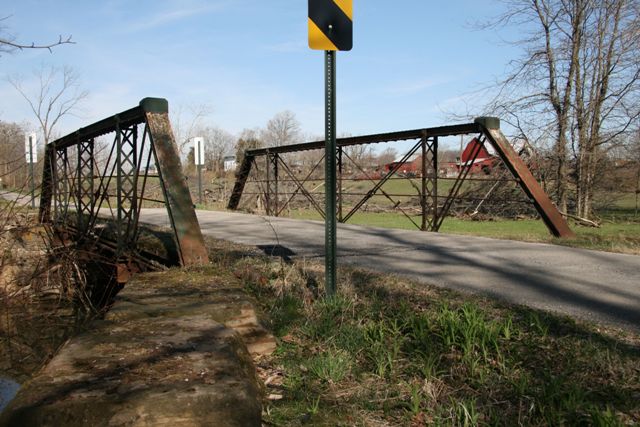We Recommend:
Bach Steel - Experts at historic truss bridge restoration.
BridgeHunter.com Phase 1 is released to the public! - Visit Now
Scottwood Road Bridge

Primary Photographer(s): Rick McOmber
Bridge Documented: April 18, 2009
Rural: Huron County, Ohio: United States
By Builder/Contractor: Wrought Iron Bridge Company of Canton, Ohio
Not Available or Not Applicable
42.0 Feet (12.8 Meters)
45.0 Feet (13.7 Meters)
15.7 Feet (4.79 Meters)
1 Main Span(s)
3940233

View Information About HSR Ratings
Bridge Documentation
View Archived National Bridge Inventory Report - Has Additional Details and Evaluation
This bridge displays the unusual designs of one of Wrought Iron Bridge Company's several different pony truss designs. It includes the unusual bolt and nut connection detail at the top chord / end post connection, as well as the cast iron assembly at that point as well. However what makes this bridge unusual is what are apparently cast iron caps that were designed to cover up those unusual connections and protect them from the elements, while also increasing the aesthetic quality of the bridge. These caps are missing on two of the corners, but remain on the other two. These caps are similar to what Wrought Iron Bridge Company used on its earliest pin-connected Pratt through truss design, however this bridge would be an extremely rare surviving example of a bridge with those caps present on a pony truss. Other surviving pony trusses of this design may have also used these caps, but if so they have been removed from the bridge in the way that two of the caps are gone from this bridge. The Historic Bridge Inventory failed to note these cast iron details, and they further dismissed the bridge since they felt it was not an early example, although the date they used was purely speculative. This bridge should be considered to be Eligible for the National Register of Historic Places for its unusual details and its retention of even some of the cast iron caps.
Information and Findings From Ohio's Historic Bridge InventorySetting/Context The bridge carries a 2 lane road over a stream in a sparsely developed, rural setting. Physical Description The 1 span, 45'-long, pin-connected Pratt pony truss bridge is traditionally composed of built-up compression members and eyebar tension members. It has U-shaped hangers for the rolled floorbeams. It is attributed to the Wrought Iron Bridge Co based on the bearing plate and exposed threaded ends of the end panel diagonals that is a telltale design of their early pony truss bridges. Those details are boxed with covers on this bridge. The bridge is supported on ashlar abutments. Integrity Appears to have integrity. Summary of Significance The pin-connected Pratt pony truss bridge is dated 1905 by the county, but it appears to be a ca. 1882 Wrought Iron Bridge Co. product given that it has their telltale connection detail at the upper panel point
where the inclined end post meets the upper chord. The design, with its distinctive upper chord panel point connection details, is characteristic of their pony trusses dating from the mid 1870s to early 1890s. The design is
described as "very popular" and having been built widely in an 1881 WIBC catalogue. The bridge also has the rolled "beaded T" section for the verticals, another feature of WIBC. The design was intended to make a stiffer section.
There are at least 13 very similar extant examples of this very design dating from 1874 to the early 1890s, and it is the early ones that are significant. Bridge Considered Historic By Survey: No |
![]()
Photo Galleries and Videos: Scottwood Road Bridge
Bridge Photo-Documentation
Original / Full Size PhotosA collection of overview and detail photos. This gallery offers photos in the highest available resolution and file size in a touch-friendly popup viewer.
Alternatively, Browse Without Using Viewer
![]()
Bridge Photo-Documentation
Mobile Optimized PhotosA collection of overview and detail photos. This gallery features data-friendly, fast-loading photos in a touch-friendly popup viewer.
Alternatively, Browse Without Using Viewer
![]()
Maps and Links: Scottwood Road Bridge
Coordinates (Latitude, Longitude):
Search For Additional Bridge Listings:
Bridgehunter.com: View listed bridges within 0.5 miles (0.8 kilometers) of this bridge.
Bridgehunter.com: View listed bridges within 10 miles (16 kilometers) of this bridge.
Additional Maps:
Google Streetview (If Available)
GeoHack (Additional Links and Coordinates)
Apple Maps (Via DuckDuckGo Search)
Apple Maps (Apple devices only)
Android: Open Location In Your Map or GPS App
Flickr Gallery (Find Nearby Photos)
Wikimedia Commons (Find Nearby Photos)
Directions Via Sygic For Android
Directions Via Sygic For iOS and Android Dolphin Browser
USGS National Map (United States Only)
Historical USGS Topo Maps (United States Only)
Historic Aerials (United States Only)
CalTopo Maps (United States Only)

